#fantasy food
Text
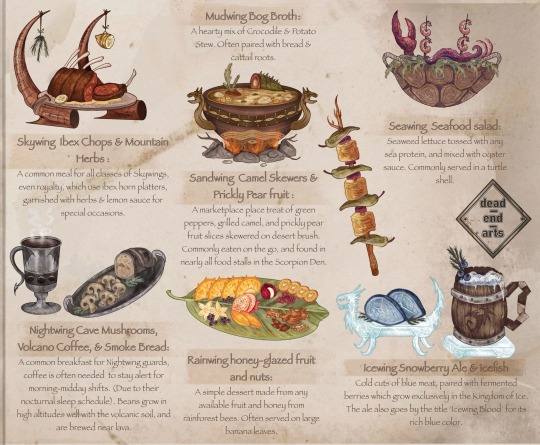
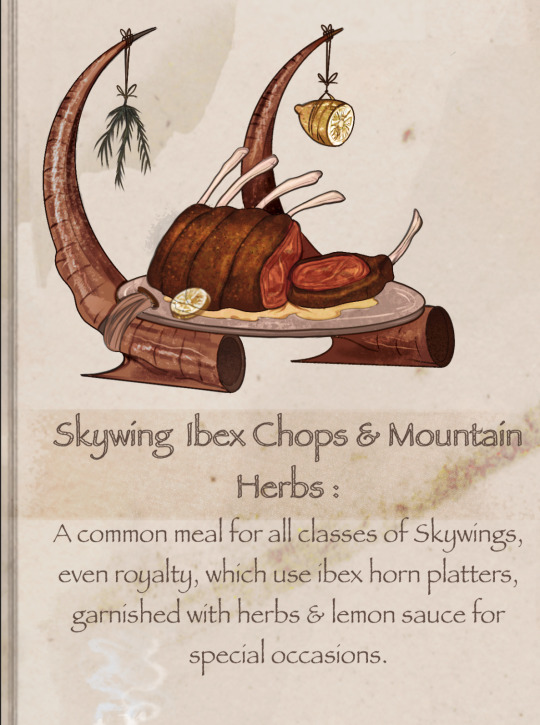





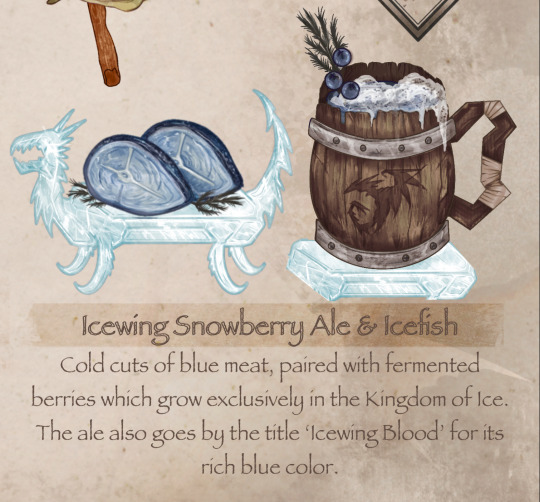

WOF tribe delicacies / treats concepts:
Hey folks! This one was the recent winner of the WOF poll, so here’s my concept art that headcannons foods each tribe is most recognized for!
We know Dragons can hunt on the go, but a prepped meal shared amongst clawmates is more cherished than picking fur out of your teeth!
Not a ton of lore undercut this time. It was super fun drawing fantasy dishes, as I rarely ever draw food or dishware. It was truly a good challenge in creativity and recounting types of the foods mentioned in the series!
#art#illustration#bookart#rainwing#icewing#nightwing#nightwing wof#skywing#mudwing#wof art#wof#seawing#sandwing#food art#fantasy food#concept art#dragon#dragon art#wings of fire art#wings of fire#wings of fire fanart#wof fanart#fantasy concept art
2K notes
·
View notes
Photo
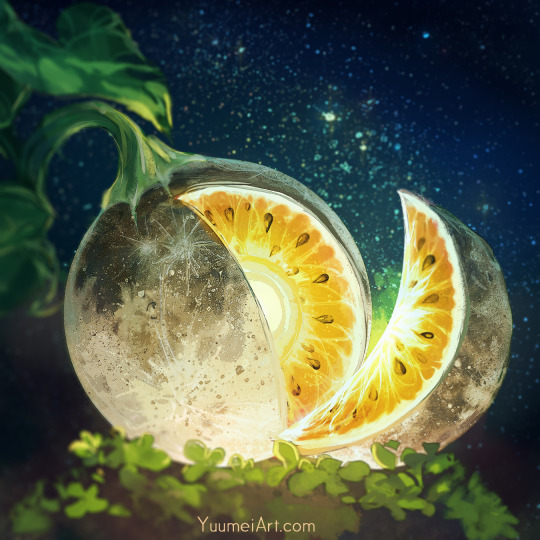
Moon Melon 🌕 🌙
26K notes
·
View notes
Text

*sets a bottle of sky sauce on your levatable*
“Your main courses will be out in a few days.”
1K notes
·
View notes
Text



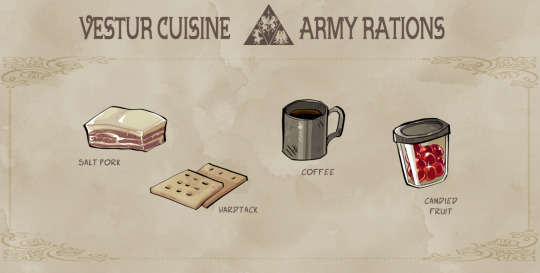
Foods of Vestur
@broncoburro and @chocodile provoked me into doing some illustrated worldbuilding for Forever Gold ( @forevergoldgame ), an endeavor I was happy to undertake. Unbeknownst to me, it would take the better part of a week to draw.
In the process, I conjured about an essay's worth of fantasy food worldbuilding, but I'm going to try and keep things digestible (pardon my pun). Lore under the cut:
The Middle Kingdom
The Middle Kingdom has ample land, and its soil, landscapes, and temperate climate are amenable to growing a variety of crops and raising large quantities of livestock. The Midland palate prefers fresh ingredients with minimal seasoning; if a dish requires a strong taste, a cook is more likely to reach for a sharp cheese than they are to open their spice drawer. Detractors of Middle Kingdom cuisine describe it as bland, but its flavor relies on the quality of its components more than anything.
KEY CROPS: wheat, potatoes, carrots, green beans, apples, pears, and grapes
KEY LIVESTOCK: Midland goats, fowl, and hogs
ROAST FOWL: Cheap and easy to raise, fowl is eaten all over Vestur and by all classes. Roasted whole birds are common throughout, but the Middle Kingdom's approach to preparation is notable for their squeamish insistence on removing the head and neck before roasting, even among poorer families. Fowl is usually roasted on a bed of root vegetables and shallots and served alongside gravy and green beans.
GOAT RIBEYE: Vestur does not have cattle – instead it has a widely diversified array of goats, the most prominent being the Middle Kingdom's own Midland goat. The Midland goat is a huge caprid that fills the same niche as cattle, supplying Vestur with meat and dairy products. Chevon from the Midland goat is tender with a texture much like beef, though it retains a gamier, “goat-ier” taste. It is largely eaten by the wealthy, though the tougher and cheaper cuts can be found in the kitchens of the working class. Either way, it is almost always served with gravy. (You may be sensing a pattern already here. Midlanders love their gravy.)
FETTUCCINE WITH CHEESE: Noodles were brought to the Middle Kingdom through trade with the South and gained popularity as a novel alternative to bread. The pasta of Midland Vestur is largely eaten with butter or cream sauce; tomato or pesto sauces are seldom seen.
CHARCUTERIE WITH WINE: Charcuterie is eaten for the joy of flavors rather than to satiate hunger, and therefore it is mainly eaten by the upper class. It is commonly eaten alongside grape wine, a prestigious alcohol uniquely produced by the Middle Kingdom. The flavor of grape wine is said to be more agreeable than the other wines in Vestur, though Southern pineapple wine has its share of defenders.
BREAD WITH JAM AND PRESERVES, TEA SANDWICHES, & ROSETTE CAKE: Breads and pastries are big in the Middle Kingdom. The Middle Kingdom considers itself the world leader in the art of baking. Compared to its neighbors, the baked goods they make are soft, light, and airy and they are proud of it. Cakes in particular are a point of ego and a minor source of mania among nobility; it is a well-established cultural joke that a Middle Kingdom noble cannot suffer his neighbor serving a bigger, taller cake. The cakes at Middle Kingdom parties can reach nauseatingly wasteful and absurdist heights, and there is no sign of this trend relenting any time soon.
CHOWDER, FARMER'S POT PIE, GRIDDLECAKES, EGGS, CURED MEATS: If you have the means to eat at all in the Middle Kingdom, you are probably eating well. Due to the Midland's agricultural strength, even peasant dishes are dense and filling. Eggs and cured meats are abundant, cheaper, and more shelf stable than fresh cuts and provide reprieve from the unending wheat and dairy in the Midland diet.
STEWED APPLES AND PEARS, JAM AND PRESERVES: The Midland grows a number of different fruits, with apples and pears being the most plentiful. In a good year, there will be more fruit than anyone knows what to do with, and so jams and preserves are widely available. Stewed fruit has also gained popularity, especially since trade with the Southern Kingdom ensures a stable supply of sugar and cinnamon.
NORTHERN KINGDOM - SETTLED
The Northern Kingdom is a harsh and unforgiving land. Historically, its peoples lived a nomadic life, but since the unification of the Tri-Kingdom more and more of the Northern population have opted to live a settled life. The “settled North” leads a hard life trying to make agriculture work on the tundra, but it is possible with the help of green meur. The Northern palate leans heavily on preserved and fermented foods as well as the heat from the native tundra peppers. Outsiders often have a hard time stomaching the salt, tang, and spice of Northern cuisine and it is widely considered “scary.”
KEY CROPS: potatoes, beets, carrots, tundra pepper
KEY LIVESTOCK: wooly goats, hares*
GOAT POT ROAST: Life up north is hard work and there is much to be done in a day. Thus, slow cooked one-pot meals that simmer throughout the day are quite common.
VENISON WITH PICKLES: Game meat appears in Northern dishes about as much as farmed meat – or sometimes even more, depending on the location. Even “classier” Northern dishes will sometimes choose game meat over domesticated, as is the case with the beloved venison with pickles. Cuts of brined venison are spread over a bed of butter-fried potato slices and potent, spicy pickled peppers and onions. The potatoes are meant to cut some of the saltiness of the dish, but... most foreigners just say it tastes like salt, vinegar, and burning.
MINER STEW: While outsiders often have a hard time distinguishing miner stew from the multitude of beet-tinged stews and pot roasts, the taste difference is unmistakable. Miner's stew is a poverty meal consisting of pickles and salt pork and whatever else is might be edible and available. The end result is a sad bowl of scraps that tastes like salt and reeks of vinegar. The popular myth is that the dish got its name because the Northern poor began putting actual rocks in it to fill out the meal, which... probably never happened, but facts aren't going to stop people from repeating punchy myths.
RYE TOAST WITH ONION JAM: Rye is hardier than wheat, and so rye bread is the most common variety in the North. Compared to Midland bread, Northern bread is dense and gritty. It is less likely to be enjoyed on its own than Midland bread, both because of its composition and because there's less to put on it. Unless you've the money to import fruit spreads from further south, you're stuck with Northern jams such as onion or pepper jam. Both have their appreciators, but bear little resemblance to the fruit and berry preserves available elsewhere in Vestur.
HARE DAIRY: Eating hare meat is prohibited in polite society due to its association with the haretouched and heretical nomadic folk religions, but hare dairy is fair game. Hare cheese ranges from black to plum in color, is strangely odorless, and has a pungent flavor akin to a strong blue cheese. It is the least contentious of hare milk products. Hare milk, on the other hand, is mildly toxic. If one is not acclimated to hare milk, drinking it will likely make them “milk sick” and induce vomiting. It is rarely drunk raw, and is instead fermented into an alcoholic drink similar to kumis.
MAPLE HARES AND NOMAD CANDY: Maple syrup is essentially the only local sweetener available in the North, and so it is the primary flavor of every Northern dessert. Simple maple candies are the most common type of sweet, though candied tundra peppers – known as “nomad candy” – is quite popular as well. (Despite its name, nomad candy is an invention of the settled North and was never made by nomads.)
TUNSUKH: Tunsukh is one of the few traditions from the nomadic era still widely (and openly) practiced among Northern nobility. It is a ceremonial dinner meant as a test of strength and endurance between political leaders: a brutally spiced multi-course meal, with each course being more painful than the last. Whoever finishes the dinner with a stoic, tear-streaked face triumphs; anyone who cries out in pain or reaches for a glass of milk admits defeat. “Dessert” consists of a bowl of plain, boiled potatoes. After the onslaught of tunsukh, it is sweeter than any cake.
NORTHERN KINGDOM – NOMADIC NORTH
Although the Old Ways are in decline, the nomadic clans still live in the far North beyond any land worth settling. They travel on hareback across the frozen wasteland seeking “meur fonts” - paradoxical bursts of meur that erupt from the ice and provide momentary reprieve from the harsh environment. The taste of nomad food is not well documented.
KEY CROPS: N/A
KEY LIVESTOCK: hares
PEMMICAN: Nomadic life offers few guarantees. With its caloric density and functionally indefinite “shelf life,” pemmican is about as close as one can get.
SEAL, MOOSE: Meat comprises the vast majority of the nomadic diet and is eaten a variety of ways. Depending on the clan, season, and availability of meur fonts, meat may be cooked, smoked, turned to jerky, or eaten raw. Moose and seal are the most common sources of meat, but each comes with its own challenges. Moose are massive, violent creatures and dangerous to take down even with the aid of hares; seals are slippery to hunt and only live along the coasts.
WANDER FOOD, WANDER STEW: When a green meur font appears, a lush jungle springs forth around it. The heat from red meur fonts may melt ice and create opportunities for fishing where there weren't before. Any food obtained from a font is known as “wander food.” Wander food is both familiar and alien; the nomads have lived by fonts long enough to know what is edible and what is not, but they may not know the common names or preparation methods for the food they find. Fish is simple enough to cook, but produce is less predictable. Meur fonts are temporary, and it's not guaranteed that you'll ever find the same produce twice - there is little room to experiment and learn. As a result, a lot of wander food is simply thrown into a pot and boiled into “wander stew,” an indescribable dish which is different each time.
CENVAVESH: When a haretouched person dies, their hare is gripped with the insatiable compulsion to eat its former companion... therefore, it is only proper to return the favor. Barring injury or illness, a bonded hare will almost always outlive its bonded human, and so the death of one's hare is considered a great tragedy among nomads. The haretouched – and anyone they may invite to join them – sits beside the head of their hare as they consume as much of its rib and organ meat as they can. Meanwhile, the rest of the clan processes the remainder of the hare's carcass so that none of it goes to waste. It is a somber affair that is treated with the same gravity as the passing of a human. Cenvavesh is outlawed as a pagan practice in the settled North.
HARE WINE: While fermented hare's milk is already alcoholic, further fermentation turns it into a vivid hallucinogen. This “hare wine” is used in a number of nomad rituals, most notably during coming of age ceremonies. Allegedly, it bestows its drinker with a hare's intuition and keen sense of direction... of course, truth is difficult to distinguish from fiction when it comes to the Old Ways.
SOUTHERN KINGDOM
The Southern Kingdom is mainly comprised of coast, wetland, and ever-shrinking jungle. While the land is mostly unfit for large-scale agriculture, seafood is plentiful and the hot climate is perfect for exorbitant niche crops. What they can't grow, they obtain easily through trade. Southerners have a reputation for eating anything, as well as stealing dishes from other cultures and “ruining” them with their own interpretations.
KEY CROPS: plantains, sweet potato, pineapple, mango, guava, sugarcane
KEY LIVESTOCK: fowl, marsh hogs, seals
GLAZED EEL WITH FRIED PLANTAINS: A very common configuration for Southern food is a glazed meat paired with a fried vegetable. It almost doesn't matter which meat and which vegetable it is – they love their fried food and they love their sweet and salty sauces in the South. Eel is a culturally beloved meat, much to the shock and confusion of visiting Midlanders.
NARWHAL STEW: Narwhal stew is the South's “anything goes” stew. It does not actually contain narwhal meat, as they are extinct (though the upper class may include dolphin meat as a protein) – instead, the name comes from its traditional status as a “forever soup,” as narwhals are associated with the passage of time in Southern culture. Even in the present day, Southern monasteries tend massive, ever-boiling pots of perpetual stew in order to feed the monks and sybils who live there. Narwhal stew has a clear kelp-based broth and usually contains shellfish. Beyond that, its ingredients are extremely varied. Noodles are a popular but recent addition.
FORAGE: The dish known as “forage” is likewise not foraged, or at least, it hasn't been forage-based in a good hundred years at least. Forage is a lot like poke; it's a little bit of everything thrown into a bowl. Common ingredients include fish (raw or cooked), seaweed, fried noodles, marinated egg, and small quantities of fruit.
HOT POT: Hot pot is extremely popular, across class barriers, in both the South proper and its enclave territories. This is due to its extreme flexibility - if it can be cooked in a vat of boiling broth, it will be. Crustaceans and shellfish are common choices for hot pot in the proper South, along with squid, octopus, mushrooms, and greens.
FLATBREAD: The Southern Kingdom doesn't do much baking. The vast majority of breads are fried, unleavened flatbreads, which are usually eaten alongside soups or as wraps. Wraps come in both savory and sweet varieties; savory wraps are usually stuffed with shredded pork and greens while sweet wraps – which are much more expensive – are filled with fruit and seal cheese.
GRILLED SKEWERS, ROAST SWEET POTATO: While a novel concept for Midlanders and Northerners, street food has long been a part of Southern Kingdom culture. You would be hard pressed to find a Southern market that didn't have at least three vendors pushing grilled or fried something or other. Skewers are the most common and come in countless configurations, but roast sweet potatoes are a close second.
CUT FRUIT AND SEAL CHEESE: Fresh fruit is popular in the South, both local and imported. While delicious on its own, Southerners famously pair it with seal cheese. Which leads me to an important topic of discussion I don't have room for anywhere else...
THE SOUTH AND CHEESE: Since the South doesn't have much in the way of dairy farming, cheese is somewhat rare in their cuisine – but it is present. And important. Cheese is the domain of the Church. Common goat dairy imported from the Middle Kingdom is turned to cheese by monks in Southern monasteries and sold to the Southern public, yes, but as you have noticed there is another cheese prominent in the Southern Kingdom diet: seal cheese. Seal cheese is unlike anything else that has ever been called cheese; the closest it can be compared to is mascarpone. It is is a soft, creamy cheese with a mild flavor and an indulgent fat content. It is used almost exclusively as a dessert, though it is only ever mildly sweetened if at all. It is extremely costly and held in high regard; the most religious Southerners regard it as holy. Dairy seals are a very rare animal and raised exclusively in a small number of Cetolist-Cerostian monasteries, where they are tended and milked by the monks. Due to their status as a holy animal, eating seal meat is forbidden. Eating their cheese and rendering their tallow into soap is fine though.
(HEARTLAND SOUTH) SOUTH-STYLE GOAT: The Heartland South is a Southern enclave territory in the Middle Kingdom. Visiting Midland dignitaries oft wrongly assume that because the Heartland South is in Middle Kingdom territory, Heartland Southerners eat the same food they do exactly as they do. They are horrified to find that familiar sounding dishes like “goat with potatoes” are completely and utterly unrecognizable, drenched in unfamiliar sauces and spices and served alongside fruit they've never eaten. Meanwhile, Heartland Southerners firmly believe that they have fixed the Middle Kingdom's boring food.
(BOREAL SOUTH) “TUNSUKH”: If Midlanders are afraid of Heartland Southern food, Northerners are absolutely furious about cuisine from the Boreal South - the most legendarily offensive being the Boreal South's idea of “tunsukh.” Southerners are no stranger to spice, so when Southern traders began interacting with the North, they liked tunsukh! It's just... they thought it needed a little Southern help to become a real meal, you know? A side of seal cheese soothed the burn and made the meal enjoyable. And because the meal was enjoyable, the portion sizes increased. And plain boiled potatoes? Well, those are a little too plain – creamy mashed sweet potato feels like more of a dessert, doesn't it? ...For some reason, Northerners didn't agree, but that's okay. The Boreal South knows they're just embarrassed they didn't think of pairing seal cheese with tunsukh sooner.
ARMY RATIONS
The food eaten by the King's Army is about what you would expect for late 1700s military; salt pork or salt chevon, hard tack, and coffee. The biggest divergence they have is also one of Vestur's biggest points of pride: they have the means to supply their troops with frivolous luxuries like small tins of candied fruit from the Midland. A love of candied fruit is essentially a Vesturian military proto-meme; proof that they serve the greatest Tri-Kingdom on the planet. Don't get between a military man and his candied fruit unless you want a fight.
#verse: forever gold#worldbuilding#fantasy worldbuilding#food worldbuilding#fantasy food#food art#animal death//#might have to proofread this later forgive any typos I am tired
499 notes
·
View notes
Text



Thought it would be fun to illustrate some Amaranthine cuisine from various regions (and time periods). Long writeups under the cut!
Western Kingdom Cuisine: Northern Upper Class
The cultural cuisine of the northern part of the Western Kingdom is shaped by the region's harsh, snowy climate. The cold meant that it was easier to keep food from spoiling, but hard to find it in the first place. During the warmer spring and summer months, food would be collected and then salted, dried, pickled, or otherwise preserved in order to last through the winter. Red meat is their primary dietary staple, and is served in a wide variety of ways, including raw and engastrated. Dairy is also common in all forms -- cheese, butter, milk, and as a component of common sauces and chowders (another cultural favorite, and great way to use up leftovers). Alcohol is also common, with a favorite cultural drink being a spiced, warmed fermented milk with a flavor similar to eggnog.
Northern dishes prioritize making use of all parts of the animal, especially nutrient-rich organ meats and fat. As a landlocked region with few rivers, fish is somewhat uncommon, but not unheard of, especially salted or pickled fish shipped in from the south. Also, as mentioned before, eating animals, including "one's own kind", is not taboo at all in this region. In such harsh climates, turning one's nose up at a filling meal is seen as ridiculous.
When good meat is available, though, presentation can get a little… creative. Or, as some might describe it, obscene. Feasts for nobles often involve whole roast hogs stuffed with turkeys stuffed with game birds stuffed with exotic, imported pickled fish, ground meat sculpted into strange and creative shapes, and other ostentatious displays. If a nobleman's chefs can do something artistic with the meat that his guests have never seen before, it's considered very impressive. Of course, to foreigners, a western kingdom noble's banquet can look rather nightmarish and grotesque. Such displays of excess are generally the realm of the wealthy, but most families will still celebrate with a "turducken" or similar engastrated roast once a year during winter feast.
Fresh fruits and vegetables make up only a small component of northern dishes. Berry preserves and pickled vegetables are prepared during the summer months, but the only "fresh" vegetables accessible during colder months are hardy root vegetables and tubers harvested from geothermal caves. Mushrooms, also harvested from the caves, are eaten in many forms.
Bread made in this region is typically very hard and dense. This "thickbread" is intended to be soaked in gravy, milk, or soup to soften it and make it more palatable. Attempting to eat the bread without softening it is a clear indicator that someone is a foreigner, or perhaps so poor that they can't afford a proper meal. Some "thinbread" is baked slightly softer and intended to be eaten in slices, but culturally, it's still expected that you put some sort of gravy or spread on it so that you don't look like a confused foreigner or destitute peasant.
For dessert, northerners often eat dessert breads soaked in sweetened, spiced cream and topped with berry preserves and candied mushrooms. Berry tarts are also made with preserves during colder months and fresh fruit during summer months, and are associated with spring, celebration, and hardship ending. These berry tarts are often eaten at celebratory dinners at the end of winter and given to students after finishing exams.
Many residents of other territories find traditional northerner food a little overwhelming due to how rich and dense it is. It can certainly take some getting used to. Eastern Kingdom residents tend to find northern cuisine especially nightmarishly grotesque and barbaric due to their cultural views around meat. However, with increased trade and travel over the last few decades, northerner food is beginning to look more like the food from the rest of the Western Kingdom, and some of the more offputting cultural practices like the ostentatious engastrated meatcraft and inedible-unless-softened bread are becoming somewhat less popular.
Eastern Kingdom Cuisine: Coastal Citydweller
The Eastern Kingdom's cuisine is similarly influenced by their climate. The desert that spans much of the region meant that, aside from its sparkling oasis cities and rim of fishing towns along the coast and major river, many residents traditionally lived a nomadic lifestyle. Additionally, unlike the Western Kingdom, they absolutely do view "eating your own kind" as tantamount to cannibalism, which meant that most red meat was only consumed during times of desperation or occasionally during holidays/rituals, though the latter is mostly seen as a weird unsavory rural thing.
The Eastern Kingdom's meat taboo generally does not extend to fish, shellfish, and insects. Fresh fish and shellfish are routinely consumed near the coast, often seared in olive oil and spices and served over a couscous-like grain base, and a salty paste made of fermented fish is smeared on bread in interior regions. Beetles coated in chopped nuts and chili powder and dried, and honeyed crickets are also popular snacks.
Eastern Kingdom cuisine also involves a lot of nuts, beans, and seeds as major dietary staples. These foods are long-lasting, spoilage-resistant, nutrient-rich, and grew easily along the banks of the kingdom's major waterway and oases even before cities settled there. These three food groups are found in nearly all of their cooking. Nuts and seeds are baked into bread and desserts but also mixed into stir fry-type dishes to add protein. A common dessert and trail snack consists of dried dates mixed with walnuts. Dates and figs are also made into jams and eaten spread over bread or as a component in sauces.
Vegetables and fruits, as well as olives, were grown in grand, sprawling, aqueduct-fed gardens in oasis cities and on riverbanks. Cacti, once cultivated extensively by ancient nomads, are served chopped and glazed with honey, another dietary staple.
Dairy, derived from pack animals used by nomads, is also somewhat common, though difficult to transport without spoilage. It is paradoxically seen as a practical, basic food by nomads and farmers, who can milk it directly from its source, something of a luxury by city-dwellers.
Additionally, the Eastern Kingdom's sprawling coastlines mean an extensive seafaring presence. As a result, they have brought back many novel plants from far afield to be cultivated in the Eastern Sultan's personal palace garden. Among these: cocoa beans, which are refined into a spicy energizing herbal drink similar to coffee. "Chocolate houses" serving this drink can be found throughout larger cites, sometimes mixing the cocoa drink with more familiar sweetened cactus juice to stretch the expensive cocoa powder further.
Post-Fall Cuisine: Ironfrost Middle Class
The society that eventually emerged after the fall of the Old Kingdoms was quite different from what came before. Though discovery of ironworking led to the rise of industrialization--processed food and automated canning, among other innovations-- the harsh, permanent winter that eventually consumed most of the continent meant that cuisine never reached the levels of decadence it had in the Old Kingdoms. This is especially true of the working class in Ironfrost, whose rather dreary cuisine is shown here.
Limited accessibility of fresh fruits and vegetables--grown in engineered greenhouses or shipped in from the far south over increasingly long distances as the cold spread southward--meant that nearly all vegetables are eaten canned. Many, especially those in rural northern towns that lacked greenhouses, may have never even seen a fresh tomato or head of lettuce before. (The City of the Sun produces fresh fruit and vegetables for the far north--including exotic apples in nigh-extinct Old Kingdom varieties--but cutting a trade deal with the reclusive city-state can be difficult due to the whims of its elusive cultish leader.)
The one exception? Mushrooms. Like the Western Kingdom northerners that lived there before them, Post-Fall societies came to rely heavily on harvesting edible mushrooms from the geothermal caves below the tundra. Mushrooms are a crucial dietary staple and can be roasted, pickled, fried, pureed, or even candied. Many of the more specialized cooking styles such as candying were passed down by survivors of the fallen Western Kingdom, thought the passage of time and changing availability of spices and other ingredients have rendered many recipes quite different from their ancestors.
Fresh meat is easier to access and easier to preserve with minimal loss of taste or texture thanks to the frigid weather providing easy "refrigeration" by way of outdoor iceboxes. However, a whole, freshly-cooked roast is still considered a rare treat for most, especially for the mine and factory workers living within the dense industrial labyrinths of Ironfrost. Canned and dried meats are popular due to being less sensitive to spoilage when kept indoors or transported across different climates.
Overall, the heavy reliance on dried and canned food means that most available ingredients are ugly, mushy, and lacking in natural taste due to the extensive preservation process. As a result, stews, loafs, and casseroles are common, as well as jellied aspic dishes. Any manner of preparation that can hide the appearance of limp, shriveled vegetables or disguise the taste of eating the same salted meat every day is useful. Creative meat presentation, such as sculpting ground meat into fun shapes, decorated meatloaf, and ornate aspic molds is another cultural holdover passed on by Western Kingdom survivors, though in the current day it's associated more with the middle or lower middle class rather than nobility. It is now more of a way to make the most out of poor circumstances than to impress fellow nobles at parties.
(Side note, not pictured: Modern day Ironfrost elite tend to favor very plain dishes made out of fresh food, garnished with sliced fruit--the mere fact that they can access such exotic fare makes their wealth self-evident! An aspiring elite with limited funds can choose to rent a bowl of Sun City apples or even an elusive pineapple to impress party guests instead.)
One of the few pieces of Eastern Kingdom food culture that survived to the present day is chocolate, though like Western Kingdom dishes, it is now quite different from its original form. These days, cocoa is blended with fat and sugar and eaten as a dessert: chocolate. This has caused its popularity to explode. Chocolate bars are incredibly popular for their delicious taste and portability, and cakes and cookies made with chocolate are coveted by the poor and wealthy alike. Of course, the cold climate means that cocoa beans can only be grown in specialized greenhouses, and the owners of these greenhouses are keen to charge a premium for access. Ironfrost and The City of the Sun are the two major cocoa producers and it's not unheard of for Ironfrost soldiers to bully smaller cocoa growers out of business to maintain their near-monopoly. Still, hidden cocoa grows scattered around the tundra ensure that a large supply of "bootleg" chocolate remains on the menu--just don't get caught with it in Ironfrost territory.
277 notes
·
View notes
Text

One of a recent set of illustration commissions for a fantasy cooking TTRPG called Monster Delicious! I LOVE to draw fantasy food, and TTRPG clients are always a delight to work with.
(PS if you need art for your game/rpg party/fantastical cookbook/etc…..get in touch!! ;3)
156 notes
·
View notes
Text

mer streetchef showing off a home-made ammonite egg soup!
#art#nevverse#fantasy#nudity cw#mer#merfolk#merrow#character design#worldbuilding#illustration#food#fantasy food#i was watching prehistoric planet. and the ammonite eggs made me hungry#ammonite
98 notes
·
View notes
Text
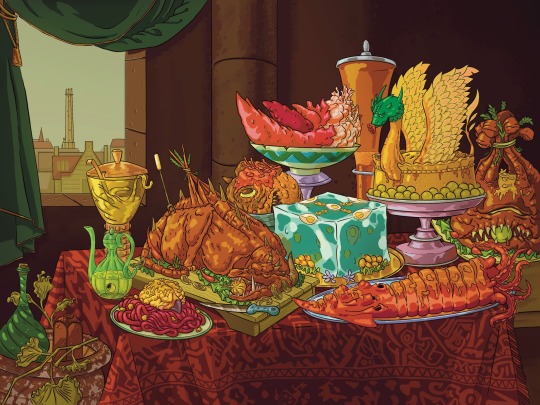
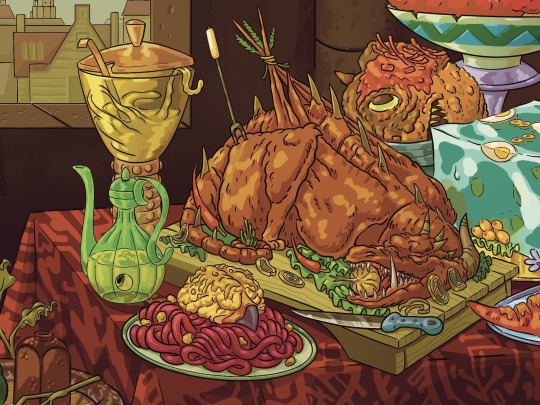


heres the finished image of my dnd feast illustration. Enjoy
33 notes
·
View notes
Text
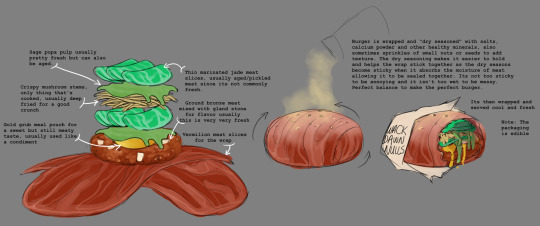


Ive been having a lot of fun designing weird food for the Feyh, they're mostly carnivores so a lot of their food is meat or meat based (with then exception of mushrooms and sugars. So gotta kind get creative to make meals that we almost recognize but are obviously very different than what we are used too.
So first thing is obviously a "burger" from their fast food resturant Wack Dawn Nulls
The second is their version of "noodles" which is known as Setti named after the actual weird mushroom is made from
And then the last is kinda a basic recipe that basically like their version of egg and milk and can be used to make something almost like bread though it be more akin to an omelette, they technically don't cook their food so the bread style wouldn't actually be common but YOU CAN EAT IT THAT WAY, they just find it unappealing.
They like their wet soup greasy foods
Other things:
- Pupa pulp is their version of "cheese" and is similar to cheese bugs that some people feed their sugar gliders, its literally the paste inside the pupa cocoon before its... fully developed so yeah...
- Grub meal is a paste that the grub themselves live in before they fully grubs, its like a weird tadpole soup that similar to egg whites
- Did I ever mention feyh are all cannibals? Ya know just putting it out there, all the meat they eat is usually from genetic meat farms or literally from other people
yeah.
86 notes
·
View notes
Text
More Hallownest foods
Fried Hopper legs and Chips: This is essentially the KFC of Hallownest. Recipe below:
First remove the legs of your hopper, taking care to remove the tough connective tissue at the base of each leg completely.
Once all of the legs have been removed gently crack the chitin but leave it on the meat. This will prevent a buildup of steam under the carapace while it's being fried.
Roll each leg in a breading(ground nuts can be used for grain intolerant bugs) and apply a health dose of salt.
Finally dunk each leg into boiling oil and cook for 2 minutes, the center of the meat should still be moist and slightly chewy.
Next make the chips: they can be made from Fallowroot tubers, but if you have them Waste-gourds are preferable because of their rich flavor and crispy texture when cooked.
Add a pinch of whatever spices you prefer.
Finally, cook them until both sides are crispy.
Gel-Salad: A dish traditonally used for dessert, it consists of a rich jelly filling(usually green or blue) and a mix of spun sugar, frostings, and pickled sugar-root. It's served in a glass bowl and made to resemble the blue lake with small lilypads made of frosting.
The size and complexity of this dish generally reflects the importance of the event it's served at. this is partially due to the cost of the ingredients.
A variation of this dish using hemolymph gelatin is often used for carnivorous bugs and makes for a better savory after meal snack.
Soul-Cider: A drink made by fermenting pale-vine berries in soul.
This drink is especially time intensive to make, and fermentation can take upwards of 30 years to be finished. Nonetheless this drink is one of the most widely produced in Hallownest and is a significant export of the kingdom as a whole.
The material the fermentation barrel is made of can drastically impact the taste, so all of the best breweries in Hallownest have been in competition to find the best material. Rumor has it that one of them even approached the white lady and asked her for a cask made from her growth.
Miner's pie: A lovely meat pie commonly made by the miners of the crystal peak, the main meat of this pie is glimback meat, and though the miners can't generally afford to be picky about what they each only the choicest cuts of glimback are tender enough to eat(specifically those directly under the shell). Special care has to be taken to remove any shards of crystal in the meat being cooked, especially because ingesting crystals is just asking for them to begin growing inside of you. A traditionally topping for Miners pie is diced Fling-weed and mashed Fallowroot.
These savory pies are generally large enough to serve 3-4 bugs and are sometimes served out of the shells of young Glimabacks which have been turned into bowls(a practice which has endangered the species)
39 notes
·
View notes
Text

25 notes
·
View notes
Text

thinking about bug foods
#cherrydraws#hollow knight#food#worldbuilding#fantasy food#bug food#hornet#white palace#hornet hollow knight#hornet hk#white lady#white lady hk#white lady hollow knight#wine#mead#hk
379 notes
·
View notes
Text
Star Fruit makes Space Jam ⭐🌟✨
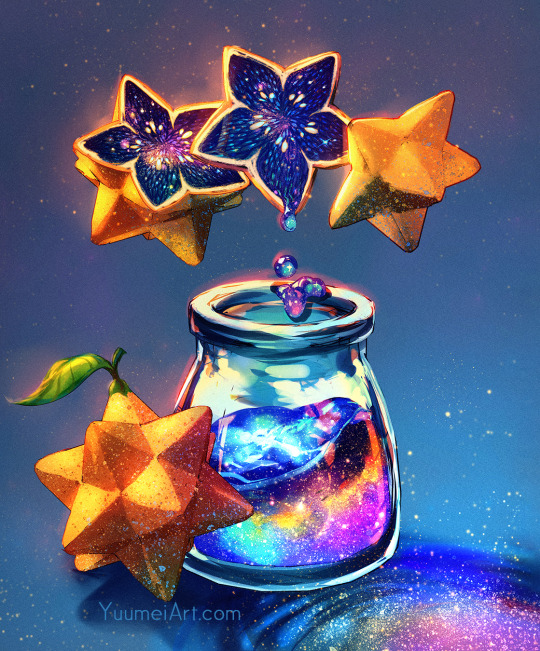
20K notes
·
View notes
Text

Your final course, rising moon roe nigiri. It tastes either sweet or savory depending on your mood :)
.
Thank you for visiting the Dreamland Sushi-ya. Don't forget, fairies eat free!
1K notes
·
View notes
Text
It always surprises me that those food from fiction cookbooks never include Otto Von Chriek’s cocoa and buns from Discworld. It’s simple enough, cocoa and hot cross buns happens to be a wonderful combination, and I just love Otto and the other black ribboners
#discworld#gnu terry pratchett#terry pratchett#otto von chriek#otto chriek#food mention#food#aesthetic food#fantasy fiction#fantasy food
18 notes
·
View notes
Text
So, I decided that to celebrate when (or if) I get to 100 followers I would create this fantasy recipe (here) from my WIP and post about it on Tumblr.

Well, looks it like I need to figure out where the hell I can find barley flour.
Thank you all so much for the support lately, its been awesome talking to y'all and learning about projects and sharing mine with you. I'm looking forward to more of it!
#writeblr#worldbuilding#writing#fantasy world#testamentsofthegreensea#fantasy food#thank you!#fantasy#fantasy writing#queer fantasy#world building
28 notes
·
View notes